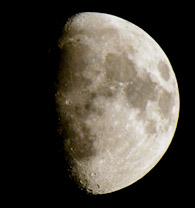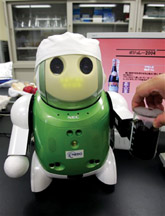|
observer |
|
|
|
|
|
OTHER LINKS |

|

|

|
Science & TechnologyAstronomers over the Moon as probe crashes on surface
Europe's first lunar mission ended its three years in space last week with a controlled and spectacular crash on the Moon, slamming into the planet's surface at 4,500 mph and creating a flash visible to astronomers on Earth. The SMART-1 probe, roughly the size of a washing machine and weighing just over 800 lb, struck a volcanic plain called the Lake of Excellence at 6:42 a. m. yesterday, at a glancing angle of between five and ten degrees. Applause broke out in the European Space Agency (ESA) control centre in Darmstadt, Germany, as Octavio Camino, the head of operations, declared: "That's it - we are in the Lake of Excellence. We have landed." The impact scattered debris over an area estimated at 30 square miles and scientists hope the dust plume kicked up will be studied by telescopes on earth to yield more clues about the origins of the Moon. One theory ESA hopes SMART-1 may shed light on is the possibility that the Moon was formed from the impact of a massive asteroid with the Earth 4.5 billion years ago. The moment of the SMART-1 impact was captured by the Canada-France-Hawaii Telescope on Mount Kea, in Hawaii. However, professional and amateur astronomers from South Africa, the Canary Islands, South America and the US mainland were also hoping to witness the collision. The Moon crash-landing was the last stage of the 16-month phase in which SMART-1 had been producing detailed maps of the Moon's composition, analysing craters and studying the volcanic processes that formed the planet. While astronauts have explored several areas of the Moon, ESA believes the information collated by its craft will create a more comprehensive picture. ESA officials said they will study all the data received over the coming days and publish results "as soon as possible". The spacecraft also tested new technologies for communication and navigation. On board the SMART-1 were a miniaturised imaging camera, an X-ray telescope, an infrared spectrometer to study minerals and an X-ray solar monitor. However, the main mission of the craft, flanked by 45 ft solar panels, was to test a new ion propulsion system officials hope to use on future interplanetary missions. SMART-1 - short for Small Mission for Advanced Research and Technology - was launched into Earth orbit by an Ariane-5 booster rocket from Kourou, French Guiana, in September 2003. The craft used its ion engine to slowly raise its orbit over 14 months until the moon's gravity came to bear. (BBC News)Deadly bug to invade UK watersIt Lacks the teeth of Jaws, but eats flesh and can turn a summer trip to the seaside into a nightmare. Experts fear the deadly marine bug could arrive on Britain's shores as sea temperatures rise. Already this year the bacterium has infected three people in Germany and killed one in Denmark. Out of ten samples of seawater tested in Germany, nine were positive for the organism, Vibrio vulnificus, according to a report presented on the first day of the British Association Festival of Science in Norwich. The bug thrives in the Gulf of Mexico but scientists believe global warming is causing it to spread north. Each year in the US, V. vulnificus infects an estimated 80 people and causes 16 deaths. Usually it is caught by exposing a wound to seawater or cutting the skin while handling shellfish. The bug can cause blood poisoning and necrotising fascitis - the "flesh eating" effect of tissue rotting away. Britain's waters are generally too cold for the organism, which prefers to live in temperatures above 20C, but shallow seas in the south can exceed this level during extreme hot spells, and may become warmer in years to come. Professor Paul Hunter, from the University of East Anglia, who has studied the reports of V. vulnificus in Europe, said: "At the moment, there's no evidence that we've got it in British waters, but nobody's looking." (The scotmanonline)UK 'in for a good shower'Britain can expect more tropical-style rainfall as climate change gathers pace, according to research carried out by Newcastle University. Scientists said extreme conditions that are likely to lead to flooding have become more common and intense over the last 40 years. They found that rainstorms have doubled in intensity in places like eastern Scotland and north-east England. Storms are also becoming more intense in autumn, threatening flood defences. Dr. Hayley Fowler, a member of the research team, said the increased frequency of such downpours will lead to more severe flooding like those experienced in Boscastle in north Cornwall in 2004. She said: "If the trend continues, which is likely, this suggests we will have an increase in flooding over the coming years which has major implications for flood risk management." Water storageThe team predicted that the five million people in the UK who live near to rivers can expected to be flooded with increasing regularity in the future. Dr. Fowler thought water companies should respond by thinking of ways for water storage during extreme weather conditions, which could then be used during drier periods. "One solution could be to build storage facilities such as small reservoirs close to rivers to catch the excess water following extreme rainfall events. "This could also help alleviate the potential for flooding as well as solve the water shortage crisis we are likely to experience in the summer months." (BBC)Robot with a 'nose' for good wine
"There are all kinds of robots out there doing many different things," said Hideo Shimazu, director of the NEC System Technology Research Laboratory and a joint leader of the robot project. "But we decided to focus on wine because that seemed like a real challenge." At the end of the robot's left arm is an infrared spectrometer. When objects are placed up against the sensor, the robot fires off a beam of infrared light. The reflected light is then analysed to determine the object's chemical composition. When it has identified a wine, the robot names the brand and adds a comment or two on the taste, such as whether it is a buttery chardonnay or a full-bodied shiraz, and what kind of foods might go well with it. Dr. Shimazu said the robots could be "personalised," or programmed to recognise the kinds of wines its owner prefers and recommend new varieties. Because it is analysing the chemical composition of the wine or food placed before it, it can also warn against fatty or salty products. Philippe Bramaz of the Italian winemaker Calzaluga said: "I see the potential to analyse expensive and old wine to say whether it is authentic or not. Auction houses such as Sotheby's and Christie's could use this technology to test wine without opening it." (Guardian) |

 Researchers in Japan have designed a robot with taste. The
electromechanical "sommelier" developed at NEC System Technologies and
Mie university is able to identify dozens of different wines, cheeses
and hors d'oeuvres.
Researchers in Japan have designed a robot with taste. The
electromechanical "sommelier" developed at NEC System Technologies and
Mie university is able to identify dozens of different wines, cheeses
and hors d'oeuvres. 







